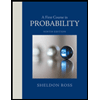It is estimated that approximately 8.14% Americans are afflicted with diabetes. Suppose that a certain diagnostic evaluation for diabetes will correctly diagnose 97% of all adults over 40 with diabetes as having the disease and incorrectly diagnoses 3.5% of all adults over 40 without diabetes as having the disease. a) Find the probability that a randomly selected adult over 40 does not have diabetes, and is diagnosed as having diabetes (such diagnoses are called "false positives"). b) Find the probability that a randomly selected adult of 40 is diagnosed as not having diabetes. c) Find the probability that a randomly selected adult over 40 actually has diabetes, given that he/she is diagnosed as not having diabetes (such diagnoses are called "false negatives").
It is estimated that approximately 8.14% Americans are afflicted with diabetes. Suppose that a certain diagnostic evaluation for diabetes will correctly diagnose 97% of all adults over 40 with diabetes as having the disease and incorrectly diagnoses 3.5% of all adults over 40 without diabetes as having the disease. a) Find the probability that a randomly selected adult over 40 does not have diabetes, and is diagnosed as having diabetes (such diagnoses are called "false positives"). b) Find the probability that a randomly selected adult of 40 is diagnosed as not having diabetes. c) Find the probability that a randomly selected adult over 40 actually has diabetes, given that he/she is diagnosed as not having diabetes (such diagnoses are called "false negatives").
A First Course in Probability (10th Edition)
10th Edition
ISBN:9780134753119
Author:Sheldon Ross
Publisher:Sheldon Ross
Chapter1: Combinatorial Analysis
Section: Chapter Questions
Problem 1.1P: a. How many different 7-place license plates are possible if the first 2 places are for letters and...
Related questions
Question

Transcribed Image Text:It is estimated that approximately 8.14% Americans are afflicted with diabetes. Suppose
that a certain diagnostic evaluation for diabetes will correctly diagnose 97% of all adults
over 40 with diabetes as having the disease and incorrectly diagnoses 3.5% of all adults
over 40 without diabetes as having the disease.
a) Find the probability that a randomly selected adult over 40 does not have diabetes,
and is diagnosed as having diabetes (such diagnoses are called "false positives").
b) Find the probability that a randomly selected adult of 40 is diagnosed as not having
diabetes.
c) Find the probability that a randomly selected adult over 40 actually has diabetes,
given that he/she is diagnosed as not having diabetes (such diagnoses are called "false
negatives").
Expert Solution
This question has been solved!
Explore an expertly crafted, step-by-step solution for a thorough understanding of key concepts.
This is a popular solution!
Trending now
This is a popular solution!
Step by step
Solved in 4 steps

Recommended textbooks for you

A First Course in Probability (10th Edition)
Probability
ISBN:
9780134753119
Author:
Sheldon Ross
Publisher:
PEARSON


A First Course in Probability (10th Edition)
Probability
ISBN:
9780134753119
Author:
Sheldon Ross
Publisher:
PEARSON
